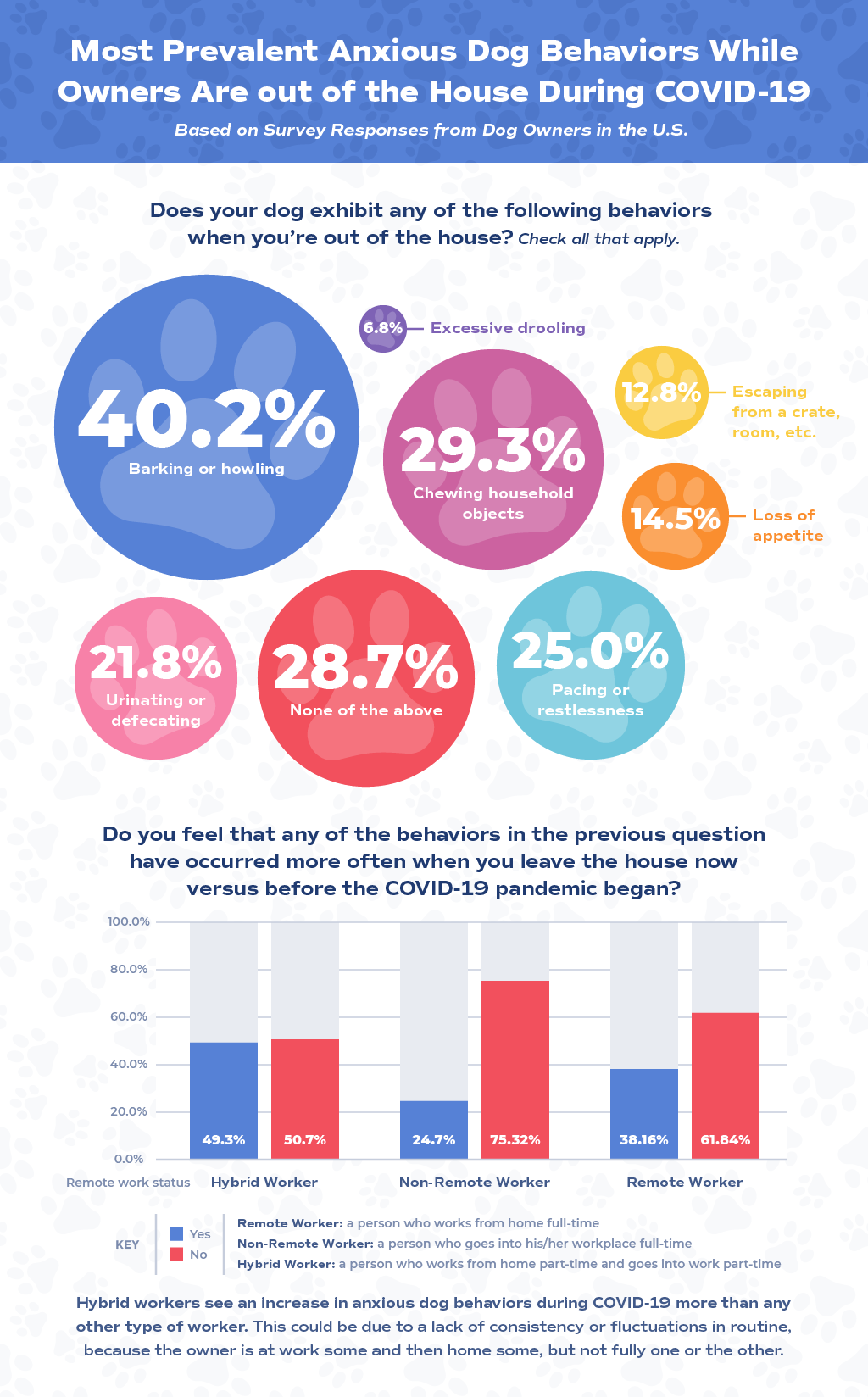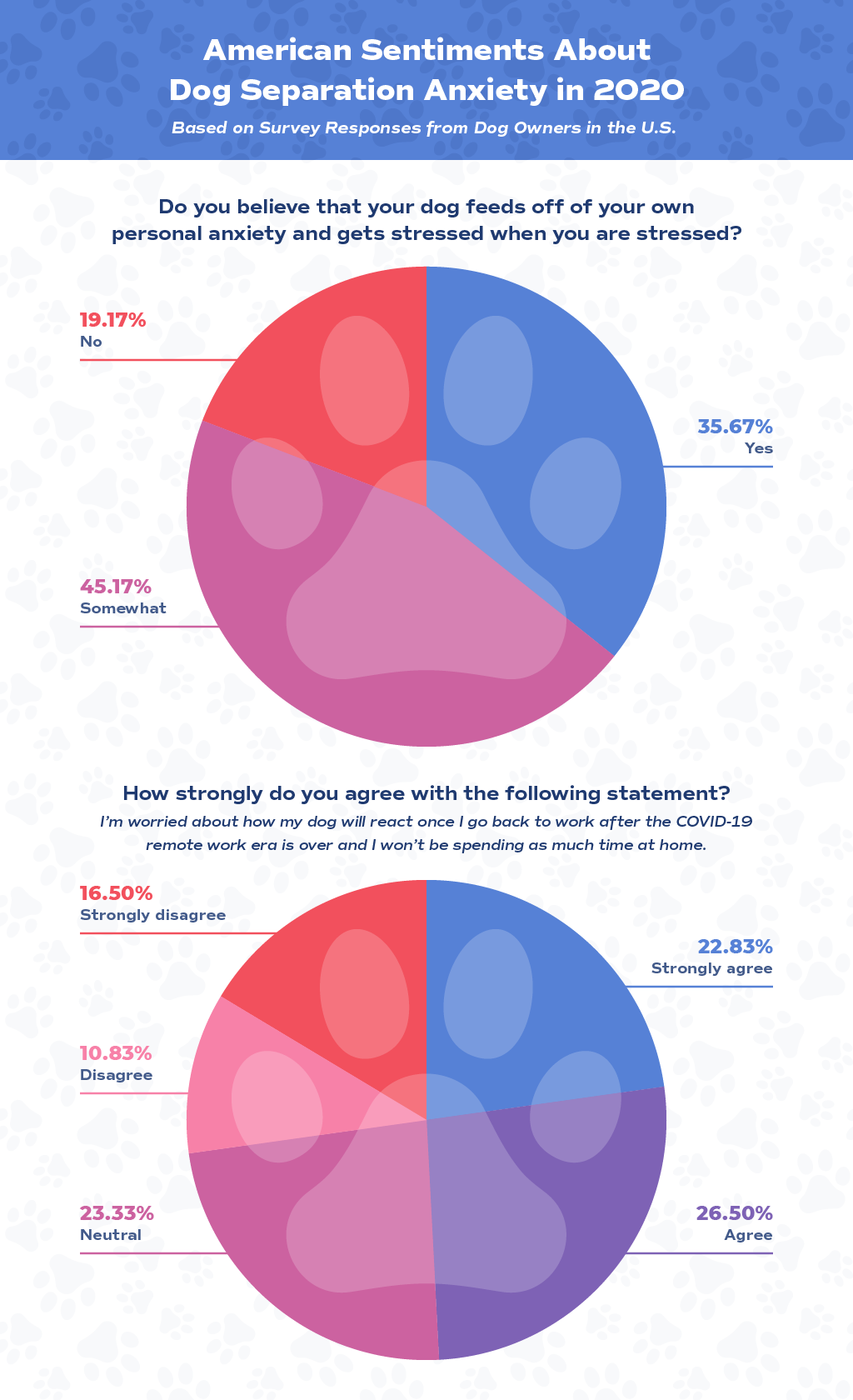How are America’s dogs handling separation anxiety? We surveyed dog owners across the country to find out.
Does your dog get underfoot as you’re headed out of the house, or become super excited to see you on your return? Does Fido destroy your shoes if he can get into the closet when you’re out -- rather, does Fido destroy whatever he can get his mouth on? Did Penny, the next-door neighbor, leave another note on your door about the howling she heard in your house while you were at work?
It’s possible your dog has separation anxiety, but you probably already knew that.
Over the last few months, the unbreakable human/pet bond has intensified even more during the remote work phenomenon of COVID-19. Many Americans thought they would be at home for two weeks, so their pets’ lifestyle didn’t change drastically during the initial days of the pandemic. However as time draws on, several months later, and we’re still at home with our pets, their day-to-day lives are different (much like ours) because we’re home so much more often than we used to be.
One of the biggest causes of separation anxiety in dogs is a change in routine or lifestyle. Now that Phase 3 is underway throughout most of the U.S., some dog owners are heading back to the office, leaving Fido and friends at home alone. Therefore, we decided to explore what pet owners will do to alleviate the stress of heading back to work and create a more comfortable living environment for their pets. To find out, we surveyed dog owners in all 50 states about how their pets experience separation anxiety.
But first, let’s take a quick look at what separation anxiety actually is.
One of the most common complaints from pet parents is that their dogs become destructive or disruptive when left alone to their own devices. Much like a parent experiences when they’re dropping a child off at daycare or preschool for the first few times, some pet parents have dogs who are particularly attached to their owner or guardian.
They become distressed when left alone which accounts for a variety of behavioral issues.
But it is more than just whining or destroying an item within reach. In fact, it’s one of the main reasons owners choose to give up their dogs or re-home them.
Every dog is an individual, which means they all have their own set of experiences with which they frame their perception of the world. From excessive drooling to dangerous escape tactics, there are a handful of common symptoms of separation anxiety.
The most common symptoms of separation anxiety include:
Over the last few months, reports of separation anxiety in dogs have risen tremendously. 61% of dog owners that we surveyed mentioned their dog exhibits noticeable signs of distress when they're preparing to leave the house during COVID-19. We wanted to know what the most common symptoms of separation anxiety in dogs during the pandemic looked like.

According to survey results, barking/howling (40%), chewing household objects (29%), and pacing/restlessness (25%) are the primary anxious behaviors that dog owners see their dogs exhibiting while they are out of the house.
Barking and howling is one of the most common ways stressed dogs handle their anxiety, regardless of the status of the pandemic. Similar to a child’s temper tantrum or a baby’s desperate cry, barking helps dogs release energy.
One insight that stands out within the survey results is that hybrid workers (people who are working at the office sometimes whereas other times they’re working remotely) struggle with separation anxiety in their dogs the most. Is it possible that because there is less routine or less predictability of schedule, the dogs of hybrid workers are more worried about when they’ll see their guardians again? Absolutely!
Aside from creating a predictable routine for your dog, there are other methods of treating separation anxiety and managing its symptoms in your dogs’ behavior.
The first step to managing or eliminating separation anxiety symptoms is to reach out to your vet to rule out any medical issues. But once that’s done, it’s time to work through teaching your pet other coping strategies to handle their anxiety symptoms.
For some dogs, the best way to alleviate anxiety is to keep the dog busy and stimulated through exercise and engagement. 54% of owners responded that this is the way they manage their dogs’ separation anxiety. Meeting all of the dogs’ biological needs helps ensure that they don’t have too much energy, which can contribute to anxiety. Over 46% of owners responded that their dogs are soothed by a special treat, such as a toy filled with peanut butter or a frozen Kong treat when their owners leave the house. Get some inspiration on how to fill puzzle toys and special treats for your dog if you haven’t tried this method before.
Other owners prepare their dogs’ by slowly teaching them how to cope while they are away. Pacing is a particularly effective method of alleviating separation anxiety in dogs. When you’re mindful of how long you’re out of the house, dogs have an easier time accepting that you’ll be back (eventually)!
Those aren’t the only ways owners are helping their dogs cope with separation anxiety.

Dog keeping, as a whole, changes based on the current research and available information. With that in mind, it’s easy to see why different generations handle certain behaviors differently. 40% of Gen Z respondents said they’d be likely to try “doggy daycare” if their dogs had separation anxiety.
Another common method pet parents are trying to help their dogs eliminate their anxiety is by utilizing CBD treats or supplements. 58% of both Millennials and Gen Z pet parents report trying CBD supplements, treats, or add-ins for their dogs.
What’s really surprising is that only 6.5% of people surveyed responded that they would reach out to a dog trainer for help with managing the dog’s behavior. And what’s even more surprising is that according to Google Trends, the monthly search volume for “dog trainers near me” has increased 50% over the past 12 months, and is steadily increasing throughout the course of the pandemic.
According to Natalie Dobkins, head trainer of Canine Performance Coach, separation anxiety is the manifestation of a variety of variables. “In order to treat multi-variable behavior like separation anxiety, you have to work on the different variables creating the behavior. Our dogs value clarity, expectations, and understanding. All of which can be expressed through crate training, tethered decompression, and structure,” says Dobkins.
It’s safe to say dogs feel “bad vibes” and can react based on the emotions we, as their pet parents, are feeling. Dogs are incredibly good at reading humans, especially their humans. That’s why we wanted to know whether pet parents thought their own anxiety could be affecting their dogs.

Though more dog owners feel like their anxiety somewhat affects their dogs (45.2%), the second most common response was that yes, 35.67% of pet owners do feel like their anxiety affects their dogs.
Our dogs look to us for cues about how to behave in certain scenarios. That’s why if you feel anxious about leaving your dog at home alone, they might also feel anxious about it.
If your dog is experiencing separation anxiety or if you’re headed back to the office soon, here’s a quick recap about the ways you can help:

